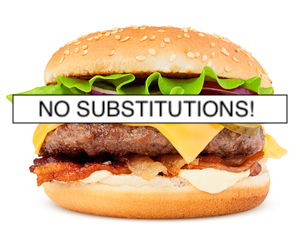As I write this, we’ve just passed May 17th and UK restaurants are once again serving diners indoors. A milestone has been reached and we have another socialising option back on the menu so this weekend I will probably eschew one of the big delivery services, plonk myself down in a favourite restaurant and remind myself how much I enjoy eating out.

I enjoy the atmosphere; I enjoy the food (and wine). I enjoy the evening off the washing up (filling the dishwasher) and I enjoy the discourse with company and waiting staff who I hope are also happy to welcome customers new and old back to their tables.
Whilst it’s hard to argue against their convenience, selecting options on an App and eating at home isn’t as fulfilling but it’s that act that’s spurred me into writing this month’s blog, which is about cheeseburgers, sort of…
From a local burger restaurant, I can order a “Classic Cheeseburger” using one of those apps. I can then remove the cheese, remove the lettuce, remove bacon, tomato and “mayo”. I can swap out the beef patty for a vegan one and also have it served without the bun, if I so wish. I can then add other toppings, perhaps some guacamole, chilli relish, macaroni cheese(!) and lots of other tempting additions and the “classic cheeseburger” ends up being nothing like originally intended.
Whilst this might appear a little odd, it’s easy to understand why. The restaurant can clearly assemble burgers in any combination from a predetermined list of ingredients. Their meals are completely customisable due to the production process they employ. Whilst they have a good idea of the variants that their customers want, they are able to change it slightly, or create something entirely different as circumstances dictate. I presume the only reason you need to select a defined menu choice on the app at all is because the operational software forces the vendor to add one, which must still be the norm in most restaurants.
I’m not an expert, but I’d imagine such a production process is a pretty efficient way of running a restaurant. Like other industries, the provision of a bespoke service with the economies that scale brings must be desired from a client service and profit perspective. If you can’t do that, you have to instead rely on a limited set of defined and fixed products and services and make the production and delivery of those as efficient as possible.
In a restaurant, you might see set or limited menus, and “no substitutions” rules for this very reason – although they might argue they’re protecting the integrity of their dishes and their subsequent reputation instead. The chef doesn’t want to relinquish creative control to the customer, seeing it as their (or the restaurant’s) responsibility alone to tinker with, tweak, or change their recipes when they, and not the customer, or other influencing factors require them.
And that, funnily enough, is a lot like traditional report production in our industry. Once client reporting has been defined, some providers are reluctant to relinquish any control over its production. They manually tinker and tweak the templates to suit their needs as and when events occur that deviate them away from the ‘standard’ reports that they’ve agreed and programmed.
Whilst we don’t criticise such an approach (it’s good when people care about the same stuff we do) it’s pretty clear that it’s not a sustainable model. When bespoke reporting is required, it’s simply not viable to perform such changes manually at scale. It takes too long. It involves too many people and subsequently costs too much. Usually, what we also see, is that such tinkering and tweaking is only really required because the data and reference tables used weren’t set up correctly in the first place. They’re not dynamic enough to adapt to circumstances that arise and therefore have to be manipulated by an operator instead. i.e. they’re forced to incur extra cost because they aren’t able to cope with all eventualities through their automated processes.
With Reporting as a Service you get decades of experience built-in and you ensure your reporting can easily and automatically flex according to reporting needs. Reporting elements automatically turn on and off as required, which can drive inclusion or exclusion elsewhere. It’s a bit like a high-performing kitchen that’s putting out the best quality meals to diners, based on their requirements, known availability of the best seasonal produce, and all produced with perfect timing and in-built quality control. And if this high level of automation isn’t enough, and the particular circumstance requires a change, our users are also able to add and remove content with the flick of a switch – well… a press of a button. All the complexity and activity involved with adding or removing elements, pages or sections from a report simply activated by a single button and taking 2 seconds to be applied – somewhat faster, simpler and easier than making changes with the traditional reporting model, which would typically involve weeks of haggling and negotiation just to secure the budget and resources.
Anyone who ordered a burger without gherkins from a fast-food chain in the 80s or 90s will know what it felt like to be standing on the side of the queue waiting for your food, whilst scores of burgers including gherkins were made and sold in front of you. That doesn’t happen anymore.
They’ve moved on and so should you.

